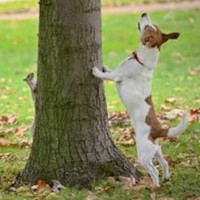Appearance of the Treeing Feist
|
| The Treeing Feist is a small dog, measuring just 30.5 to 46 centimeters at the withers and weighing up to 14 kilos. Their coat is short, soft and relatively dense, but it's difficult to identify them solely on the basis of pattern or color, as even the breed standard confirms that they can come in any combination. The head is long and relatively slender, with the skull slightly longer than the muzzle, both parallel but separated by a well-defined stop. Its nose is generally black, if not unicolored, and its eyes range from brown to amber, but rarely appear in any other form. Ears are high-set, somewhat triangular and either erect or button-shaped. The neck is clean, muscular and of medium length, with relaxed shoulders and a regular topline. Its forelegs are straight, strong and surprisingly robust for their size, and its elbows are tight but move unhindered close to the rest of the body. Their chest is relatively deep and broad for their body size, giving them surprising barking power, and their belly is only moderately tucked in. Their hindquarters are considerably muscled, especially in the thigh, giving them great pushing power in any direction they choose. The tail can be long and tapered or naturally curled. |
Temperament of the Treeing Feist
|
| Although they have high energy, prey drive and activity when outdoors and around potential things to chase, Treeing Feist are relatively easy-going inside the house and are perfectly content to lounge around with the family if that's the group activity. They are known to be affectionate and playful, with some of the smaller dogs even taking on the role of lapdog if allowed. They generally behave well with children, but must be carefully trained and socialized to minimize any potential problems. Training itself is not particularly difficult, but it does require firmness and consistency from the outset, otherwise the dog may take advantage and try to be the alpha or, worse still, develop small dog syndrome. Because of their high energy levels, they need regular exercise, but because of their size, they fall somewhere in the middle of most breeds in terms of needs. However, if they don't get regular exercise, they are very likely to become bored or frustrated, and therefore destructive. So offer them daily walks or runs, as well as a little mental stimulation to keep them happy. They are relatively friendly with other dogs, but are often wary of strangers and tend to make a lot of noise if they are frightened or sense a potential threat. For some, this can be a source of annoyance, but for others it simply makes them a good watchdog as well as a hunter or companion. If trained to react in a specific way to strangers from the outset, they can usually adapt quite easily. Because of their size and general adaptability, they adapt pretty much equally well to any type of living situation or home environment, provided they receive adequate attention and exercise. |
Needs and activities of the Treeing Feist
|
| The Treeing Feist is considered a medium- to high-energy dog and therefore needs a good dose of daily exercise to perform at their best and stay healthy. Because of their size, they don't need as much exercise as a larger dog with the same drive, but they still need around 60 minutes of activity a day, ideally between walks and runs on leash, romping in the dog park or yard, and games that will also stimulate them mentally. Their hunting instinct can sometimes become a source of trouble, whether on or off leash, so the earlier the training, the better. |
Maintenance of the Treeing Feist
|
| Treeing Feists are considered low-maintenance dogs, as they have been bred to be. They shed only moderately and need brushing only once or twice a week to keep their coats clean and healthy. They don't usually need bathing, unless they're in something particularly dirty or foul-smelling, and they look after themselves very well. Otherwise, their nails should be checked and trimmed if necessary to avoid problems with cracks or breaks, and their teeth should be brushed weekly to help them maintain good oral health. By doing so, you'll avoid costly expenses; many owners choose to have their dog's teeth cleaned by the vet on an annual basis. |







 English (United Kingdom)
English (United Kingdom)